Notice:
We are not medical doctors, and you should not rely on the information on this page solely for medical treatment of Plantar Fasciitis. You should consult and rely on your medical doctor for treatment.
Summary:
Plantar Fasciitis (pronounced "plan-ter fash-ee-eye-tus") is a flat ligament that connects the muscles on the bottom of your foot to the heel bone. This ligament is actually called the Plantar Fascia Ligament. There are three Plantar ligaments on the bottom of your feet. When there is a strain or tear in the ligament it causes heel pain as you walk. The most common cause of this tear is caused by the lack of arch support in your shoes. Resolving the heel pain can be complicated and may take several months to a year to resolve. Less often heel pain can also be caused by arthritis, bone fractures, ACL issues, or tarsal tunnel syndrome (nerve problems) This page only covers self treatment of plantar fasciitis ligaments, and common methods of resolving the problem. The most common mistake that people make is to ignore the heel pain while thinking that it will take care of itself. This mistake often results in additional months to healing the ligament.
You are more likely to have this problem if you have some of the following conditions:
Tying your shoes too tight - prevents proper extention and contraction of ligaments
Backpackers are more likely to have problems - too much weight
High arches or flat feet
Your shoes do not have proper arch support
You suffer from inelastic connective tissue disorder
You are overweight
You are middle aged
You are a hiker or spend a lot of time on your feet
You spend a lot of time standing still on rocks or concrete
The number one reason most hikers injure their Plantar Fascia Ligaments is by tying their shoes too tight. If you tie your shoe laces too tight, it will prevent the proper stretching and relaxing of the ligaments. This results in inflammation and tearing of the ligaments. Think of the ligaments like a rubber band. It needs to stretch and then relax.
When you hike or walk, your heal should naturally lift off the shoe insert just slightly. It if does not lift up, then your shoes are tied too tight. If your shoes are tied correctly, you should wear a hole in your sock on the bottom of your heal. Some hikers tie their shoes tight to help with ankle support. If you feel that you need more ankle support, buy ankle supports.
Overview of ways to accelerate the healing of your Plantar Fasciitis Ligament:
Purchase the best arch support inserts for your shoes.
Increase your calcium intake to accelerate ligament repair by the body.
Extending the plantar fasciitis ligament while your body repairs the tear.
Stretching the plantar fasciitis ligament after resting or sleeping.
Reducing the inflammation of the fasciitis ligament
Shoe Inserts with the PROPER Arch Support:
Shoe manufacturers often do not supply arch support inserts for their shoes. Most shoes come with inserts that are made for people with flat feet. The reason why is because if they provided arch support for their shoes, people with flat feet would not buy their shoes. This would reduce their shoes sales by 5-10%. So, they just do not provide arch support. Unfortunately, there is a small percentage of the population will develop plantar fasciitis damage due to this policy. The damage that they cause is very significant. Some people will endure years of misery. And, once you have had Plantar Fasciitis, you will likely get it again at a later date.
Your first step should be to purchase shoe inserts that will properly support your arches. There are a large selection of shoe inserts to pick from. Some inserts can make your problem worse, while others will help you resolve your problem.
Let's start with the worst inserts. Do NOT buy any inserts with gel heel padding. Gel inserts will tear the ligament further. The gel will cause your foot to move around and tear the plantar fascia ligament further. Furthermore, it acts as an insulator and will cause the inflammation to get significantly worse. Almost everyone reports that Gel inserts made their plantar fasciitis significantly worse.
There are many levels of shoe inserts with arch support. Some people have a small arch. While others have a normal arch. Then there are others with high arches. There are many choices to pick from. Higher price inserts does not necessarily means that it is better. The cheapest inserts are pre-made to a certain arch support. Finding the right one that works can be a long process. And, you may have to purchase many inserts until you find a good one. Those pre-made inserts usually range from $5 to $50 per pair. The next level is to buy a set of shoe inserts that are heat moldable. You will put the inserts in a kitchen oven at 200F for a certain period of time. You will remove them from the oven and put them in your shoes. You will then put your feet in your shoes on and stand in them for 15 minutes. They will change shape to perfectly fit your feet. At the time this page was written, these seem to be the best choice for most people. The most common manufacture of these shoe inserts is Softec. They usually cost between $40 to $60 per pair. We recommend the ones with the most padding. The last option is to have a custom made orthopedics shoe inserts made. In our experience they do not always fit properly. They can cost between $100 and $500 per pair. If you have certain foot deformation, then custom orthopedics may be the best choice.
It is very strongly advised that you use the shoe inserts ALL the time. You should never walk without them in your shoes. This including walking around the house. Especially, if you walk on concrete or tile floors. Some people will put inserts in their slippers in the Winter months. Some people will put inserts in higher-quality sandals (like Teva's) in the Summer months. Even if you get up during the night to use the bathroom, you should wear something with inserts in them. Some people even have something for the shower. The idea is that you never walk or stand without some type of shoes with inserts. Walking 20' feet across the floor without arch support can cause a healing ligament to tear again. Then you are back at square-one to start the process all over again. This is one of the reasons why it takes so long to resolve.
Putting your feet in the proper position to heal correctly:
In spite of the fact that it takes many months to fully cure your plantar fasciitis, your body will make significant progress on repairing the tear in several hours. For example, if you have been hiking, and your feet seem to move up-and-down just fine. Then you drive an hour home. When you get out of the car, your feet suddenly have difficulty in moving. They feel stiff. Your body has already started to heal the tear. But, as you walk with your stiff feet into the house, you end up tearing the plantar fascia ligament again. This is a process that will take place over-and-over again.
The key to successfully repairing your plantar fascia ligament is to have your foot properly positioned prior to letting it heal. The best time to do this is when you go to bed in the evening. Then your body has all night to start repairing the ligament. The proper position at the right time is the key to successfully repairing the ligament properly. The proper position is to have the front of your foot extended upward as far as they will stretch. You also want to extend your big toe upward and back as far as it will go. If the ligament is not stretched out completely, it will heal to a shorter length, and the next morning you will tear it because it is too short. Since it is very uncomfortable and unnatural to hold your foot and toes all the way upward, you will need some help to keep them extended. The best device is a foot brace or a foot sock. Once the ligament starts to heal at the fully extended position, it will heal properly.
When you wake up in the morning you will need to carefully stretch the ligament out before walking on it. But, we will cover the next step after we talk about increasing your chances of healing the plantar fascia ligament faster with the intake of calcium.
Increasing your Calcium intake to Accelerate Ligament Healing of the Tears:
To repair the plantar fascia ligament takes calcium to repair the tendon. Most people have enough calcium for normal living. But, if you need to repair ligaments and tendons, you need a higher amount of calcium. Increasing your calcium levels will dramatically shorten the healing time of the plantar fascia ligament. Ironically, women are more likely to have plantar fasciitis. It is also a well known fact that women need to watch their calcium levels. Most women have an inadequate level of calcium once they become middle aged.
Your body will excrete certain vitamins and minerals if the level becomes too high. Calcium will NOT be excreted by your kidneys if the level becomes too high. Too much or too little calcium can be dangerous to your health. If you become concerned about your calcium levels have your doctor measure it during this process.
Calcium supplements come in doses of 400mg to 1200mg. Most people report that taking smaller doses twice a day works better then one large dose once a day. Most people take a 400 or 500mg dose once in the morning, and another equal dose in the evening. This will spread out your calcium supplements to maintain a more steady level. Once you have cured your plantar fasciitis, you would want to reduce the calcium supplement level. You can do this with your physician with a simple blood test.
People who are lactose intolerant or who are allergic to dairy products will often have low calcium levels. They need to pay attention to their calcium levels. Dairy products are rich in calcium.
Stretching your Plantar Fascia Ligament is very important to prevent further tearing:
When you wake up in the morning, the first thing you want to do is to start to move your feet up-and-down for about 30-60 seconds. Try not to extend or contract them completely. Once you have done this, then start to extend them completely, but not to extend them so far that they will tear the ligament. Be gentle. Then sit up in bed with your feet on the floor. Put some shoes on. Then with a little weight start to stretch the ligaments gently. Keep working on stretching them gentle while adding more weight. Finally, you will want to move to a squatting position to fully extend the ligament. This procedure will help stretch out the ligament slowly and carefully.
As you slept, your body used the calcium to repair your ligaments. But, sometimes your body uses too much calcium and this makes your ligaments inelastic and stiff. By carefully and gently stretching your plantar fascia ligament, you will make your ligament more elastic. If you do it too quickly, you will tear the ligament again.
If you have been sitting in a chair for an extended period of time during the day, you should follow this procedure again.
Ways of Reducing the Inflammation caused by the Ligament Tear:
Inflammation plays an important role in Plantar Fasciitis. A majority of the time needed to heal Plantar Fasciitis comes from the reduction of the inflammation. Reducing the inflammation seems to be a difficult part of the process. Part of the problem is that your heel is in your shoe, and this cause heat to build up around your Plantar Fascia Ligaments. When your Plantar Fascia Ligament has inflammation this will cause further tearing of the ligament. So, it becomes critical that inflammation is attacked aggressively.
The inflammation is caused by the tear in the plantar fasciitis ligament. When you feel heel pain there is inflammation. Most of the pain comes from inflammation. Sometimes your heel will throb with pain. Part of the process of healing the plantar fasciitis ligament is to reduce or eliminate the inflammation. It is a big part of the battle. There are a number of ways to reduce inflammation in your heel:
Take NSAID anti-inflammatory drugs like Advil.
Cool your heels with a bath of cold water or swimming.
Cook your heels with a fan flowing on your feet while you sleep.
Wear sandals with strong base with shoe inserts during the day to keep your feet cool.
By far, cooling your feet at night with a fan works the best. You may wake up at night because your feet are cold. But, it will help reduce the inflammation. If you toes get cold, you can put a sock on half-way across the bottom of your foot. Then fold the upper part of the sock back towards your toes. In the colder months, so people will cut the heal out of thermal hiking socks to keep their feet warm, while chilling their heels. Most people report dramatic reduction of inflammation by using this technique.
When hikers get Plantar Fasciitis, this will leave them without the normal exercise they need and desire. Swimming can help reduce inflammation while providing some necessary exercise. Cooling your feet in a bath of water will provide very short term relief, but does little to advance the permanent reduction of inflammation.
Taking NSAID's while cooling your feet is also very helpful. Reducing the inflammation should be done throughout the healing process. But, this is the last phase that needs to be done before you are healed. Even as your feet stop hurting, you should continue this process until you are fully healed.
Another important step during the healing process is to keep your feet cool as possible and keep pressure off the heal. One mistake people make is that they tie their shoes too tight. This puts pressure on your heel, and keeps the heat around your heel, and will increase the inflammation. It will also prevent the movement of the Plantar Fascia Ligament, and this additional friction will dramatically increase the inflammation. If you can wear stiff sandals (like Teva's) in the summer months will keep your feet cooler.
Other Tips:
When you walk, you should try to step down to the ground with the ball of your foot, instead of the heel. This will take the pressure off the heel, and help keep the pain and inflammation down to a minimum. This will require you take take smaller steps, and moving slower. It will take a little while to learn how to walk on the balls of your feet.
One mistake that some people make is to not address Plantar Fasciitis when symptoms appear. Some people believe that they can walk it off. This usually makes the tear bigger, and will extend the healing and recovery period. It is also possible to completely tear the ligament. In this case, you will need surgery to repair the ligament.
If you have the ability to stay off your feet for a week, this will drastically reduce the recovery time. Not that many people can get the time off, and stay off their feet. In cases where the Plantar Fascia Ligaments do not heal, some doctors will put the patients foot in a cast for 4-6 weeks.
Some doctors will also inject steroids into the patient's foot. This will dramatically help the healing of the ligaments.
Some doctors will recommend surgery to repair the torn ligament. Studies show that there is about a 40% failure rate.
It is easy to become demoralized by the long recovery period. The key is to keep up with all the steps of getting the tear to heal, and keeping the inflammation down as much as possible. As time passes, you will begin to notice that your feet are getting a little bit better each day. And, don't be discouraged by setbacks.
Once you have had Plantar Fasciitis, you are much more likely to get it again at a later date. It is important to take care of your feet after it has healed.
|
 |
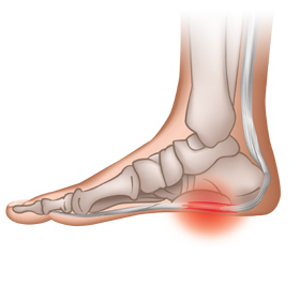 |
 |
Location of tears of the Plantar Fascia |
 |
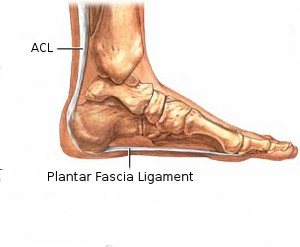 |
 |
Location of Ligaments |
 |
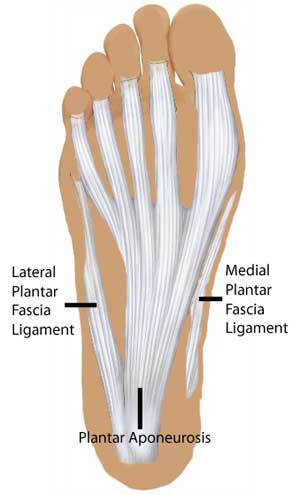 |
 |
Location of the 3 Plantar Fascia Ligaments |
 |
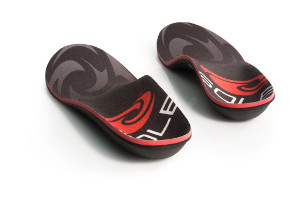 |
 |
Softec Heat Moldable Inserts |
 |
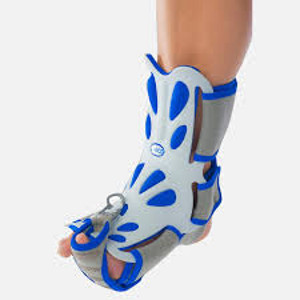 |
 |
Foot Brace to allow healing of Plantar Fascia in the correct location |
 |
 |
 |
Ankle Support Device |
|

